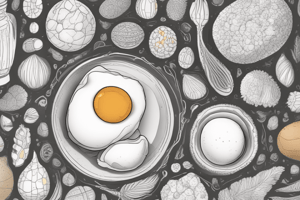Podcast
Questions and Answers
What is the primary purpose of cone-shaped eggs in certain species?
What is the primary purpose of cone-shaped eggs in certain species?
- To provide insulation
- To allow for faster hatching
- To attract predators
- To prevent rolling and falling (correct)
Which of the following animals is known to have a unique method of carrying fertilized eggs?
Which of the following animals is known to have a unique method of carrying fertilized eggs?
- Echidna
- Nile crocodile
- Male seahorse (correct)
- Jawfish
What type of nesting behavior do crocodiles exhibit when laying eggs?
What type of nesting behavior do crocodiles exhibit when laying eggs?
- They lay eggs in shallow water
- They build mounds of dirt, leaves, and grass (correct)
- They carry their eggs in their mouths
- They dig holes in tree trunks
In terms of parental investment, which statement is true about most bird species?
In terms of parental investment, which statement is true about most bird species?
What is the function of the egg tooth in newly hatched echidna young?
What is the function of the egg tooth in newly hatched echidna young?
Which reproductive strategy is exhibited by the male midwife toad?
Which reproductive strategy is exhibited by the male midwife toad?
What physical changes occur in chicks as they develop inside the egg?
What physical changes occur in chicks as they develop inside the egg?
What variety of egg shape is NOT typically found among egg-laying species?
What variety of egg shape is NOT typically found among egg-laying species?
How long does chick development typically occur before hatching?
How long does chick development typically occur before hatching?
What adaptation allows lacewing eggs to protect themselves from predators?
What adaptation allows lacewing eggs to protect themselves from predators?
Flashcards are hidden until you start studying
Study Notes
Overview of Eggs
- Eggs are nutritious food commonly consumed in various forms: boiled, scrambled, and fried.
- Most eggs consumed by humans are laid by chickens, but multiple animals also lay eggs.
Egg Laying Animals
- Birds, insects, spiders, amphibians, fish, and reptiles all reproduce by laying eggs.
- Egg shapes, sizes, and colors vary widely across species, including cone-shaped, oval, round, and flat.
Special Adaptations
- Cone-shaped eggs prevent rolling and falling from ledges.
- Eggs with spiral patterns (e.g., those of the horn shark) grip rocky surfaces or sand.
- Lacewing eggs hang from stalks, protecting them from predators.
Nesting Behavior
- Some mother animals build nests for laying eggs, providing safety and insulation.
- Nest types vary, including shallow scrapes lined with vegetation to keep eggs warm.
- Crocodiles bury their eggs in mounds of dirt, leaves, and grass, while sea turtles dig nests in sand.
Parental Investment
- Not all birds or animals care for their eggs after laying; some, like the Nile crocodile, are protective.
- Certain species show a range of parental involvement, from guarding nests to leaving eggs unattended.
- Male midwife toads carry fertilized eggs in jelly-like strings for protection.
Unique Parental Roles
- Jawfish guard eggs in their mouths, while male seahorses carry eggs in their pouches until birth.
- Most mammals do not lay eggs, with exceptions like the platypus and echidnas.
- The echidna's egg is oval; newly hatched young, called puggles, use an egg tooth to break out.
Development of Chicks
- Chick development occurs within 21 days, nourished by the yolk while receiving air through shell pores.
- Physical changes in the chick include the development of a beak and feathers over time.
- The hatching process involves "pipping," where the chick breaks through the shell using strength.
Growth and Maturity
- After hatching, chicks dry their feathers and develop quickly.
- Within five to six months, they reach maturity and can begin laying eggs.
Chicken or Egg Dilemma
- The question of which came first, the chicken or the egg, remains a philosophical conundrum.
Overview of Eggs
- Eggs are a versatile and nutritious food, often prepared by boiling, scrambling, or frying.
- Chickens are the primary source of eggs for human consumption, although many other animals also lay eggs.
Egg Laying Animals
- A diverse range of animals reproduce by laying eggs, including birds, insects, spiders, amphibians, fish, and reptiles.
- Egg characteristics vary significantly, with shapes like cone, oval, round, and flat, reflecting adaptations to environments.
Special Adaptations
- Cone-shaped eggs are adapted to prevent rolling off ledges, ensuring survival in certain habitats.
- Spiral-patterned eggs, such as those from horn sharks, adhere to surfaces, providing stability in their environment.
- Lacewing eggs are uniquely positioned on stalks to thwart predation and increase chances of survival.
Nesting Behavior
- Mothers in various species build nests to lay eggs, providing essential safety and thermal insulation for the developing young.
- Nest types range from simple vegetation-lined scrapes to structured in-ground mounds, as seen in crocodiles.
- Sea turtles dig nests in sand, showing a significant variation in nesting strategies among egg-laying animals.
Parental Investment
- Not all species demonstrate parental care; some, like Nile crocodiles, actively protect their eggs, while others may abandon them.
- Parental behavior varies greatly, from vigilant guarding to complete neglect of the eggs.
- Male midwife toads exhibit unique care by transporting fertilized eggs in jelly-like strings for added protection.
Unique Parental Roles
- Jawfish engage in a distinctive behavior by guarding fertilized eggs inside their mouths until they hatch.
- Male seahorses participate in a remarkable reproductive role by carrying eggs in their pouches until birth.
- Most mammalian species do not lay eggs, with notable exceptions being the platypus and echidnas, which are monotremes.
Development of Chicks
- Chick growth within eggs generally takes about 21 days, relying on yolk for nutrition and oxygen accessed through shell pores.
- Chicks undergo significant physical development, including the formation of beaks and feathers as they prepare to hatch.
- The hatching process begins with "pipping," where the chick uses its strength to break through the eggshell.
Growth and Maturity
- Newly hatched chicks dry their feathers rapidly and exhibit swift growth.
- Within five to six months post-hatching, chicks usually attain maturity and can start egg-laying themselves.
Chicken or Egg Dilemma
- The philosophical question of which came first—the chicken or the egg—continues to intrigue and puzzle thinkers across cultures.
Studying That Suits You
Use AI to generate personalized quizzes and flashcards to suit your learning preferences.




